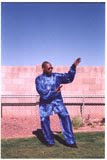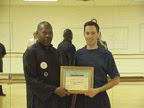Namaste’ Students and Readers!
A new semester will be starting in a few weeks and that means another semester of Kung Fu and Qigong training. We hope you will register early and spend the next few months doing what we do so well together. We have fostered a wonderful spirit of cooperation, support, and team work in our classes which I’m sure is one of the reasons that we have students come back and repeat the classes for years. Our senior instructor
Seifu Andrew will be teaching the Friday afternoon Qigong class (as well as an evening Kung Fu during the week) and I will be teaching the Friday morning integrated (beginners and intermediate students) Kung Fu class. I’ve discussed the entire
1st Rank Lesson Plan in my previous Posts and encourage new students to read and intermediates to review what has been said.
As some of you know I grew up in Harlem, N.Y. during the 60’s and 70’s and it is there that I had my first and lasting exposures to the martial arts. After messing around in a few systems and styles I found
Grand Master Alan Lee and the
Chinese Kung-Fu Wu-Su Association in downtown Manhattan. Although some other really great martial artists had a significant influence on my martial arts development it is Grand Master Alan Lee’s teachings that are most visible in what we do and how we do it. It is his take on
Shaolin Kung Fu that permeates the
7 Circles System of Southern-Northern Shaolin Kung Fu Wu Su. I believe that most people who come to the martial arts – and stay – are looking for something special. They are curious and seeking to unlock certain mysterious and hidden potentials that push and pull on them from within. They are looking for something that they can use as an anchor for their sense of self, something that is dependent completely upon them and their choices.
Ultimately, the one thing that we can control is our own body-mind-spirit and the Traditional Martial and Healing Arts brings each student face to face with the ultimate challenge – to master self, and the ultimate reward – self-discipline. Thinking of our Four Principles – Humility, Kindness, Patience, and Discipline – they all emanate from the power of the self and the first three – humility, kindness, and patience – are all dependent on the fourth – discipline, self-discipline.
Self-discipline may keep you committed to something that you do not want to do but self-discipline alone will not enable you to achieve your highest potential. Another important ingredient is
passion –
a love for what you do! Like me and hopefully like you, millions of people around the world feel that passion for the martial arts, and if we include China, Thailand, and India the numbers are in the billions. The martial arts feed that passion that we all feel in some very important and impressive ways.
What do we study Kung Fu? Because is feeds our body-mind-spirit in a perfect and satisfying way.
Body
Martial Arts training is one of the best ways to keep you body in tip-top shape. The body thrives on movement and kung fu offers us a wide range of body movements from which to choose. When we train it is All-Systems-GO! Every part of your body gets engaged in the process.
Punching, kicking, stepping, spinning, jumping, blocking, and locking movements require that the bones, joints, muscles, ligaments, tendons, nerves, heart, lungs, eyes, ears, arms, hands, fingers, legs, feet, and toes all work together in a coordinated effort towards perfection. During training we demand that our bodies exceed the normal demands that we place on it in our everyday lives. And every time your body responds to that demand, every time you push it towards peak performance, after every class you feel that you have the ability to accomplish any goal that you set in your mind.
Your heart becomes stronger, your circulatory system becomes healthier, your lungs function more efficiently, and you begin to move more gracefully and with greater agility. Suddenly you realize that you feel more comfortable in your body and it rides like a well-tuned finely crafted automobile. It is after all – your ride.
Why shouldn’t you ride in the best? Especially if it is completely up to you to keep it mint condition.
Mind
Training in the martial arts has a positive effect our minds in several ways. First comes an enhancement in
focus and
awareness.
This ability to concentrate – to be in a state of mindfulness – emerges from the demand that perfect body movement places upon the mind. In order to master the techniques of your art you must first learn to mimic the movements of your teacher. This requires that you pay attention both to the teacher and to yourself. Your body communicates to you when your technique is imperfect and you can only hear its messages if you are mindful, focused, aware, and in the moment.
Can you name one area of your life where the ability to focus, be mindful, be aware, and in the moment would not benefit you? Doubtful! As your mind learns and develops these powerful lessons it does just apply them in the arena of your training. It applies them in every area of your life because through training you become a focused, mindful, and aware individual. Those characteristics become a part of you– a part of your core personality, your
Ase Ami (Energy Signature).
The martial arts are based around
fundamental principles of mathematics and science. I discussed this in my last Post. From your basic movements through to your advanced techniques and fighting you are engaged in a mathematics and science-based problem solving process either trying to master a particular technique or trying to out-maneuver an opponent.
Traditional Martial and Healing Arts training requires that you control your emotions, that you avoid anticipation or prejudgment, that you seek to return your environment to a state of harmony, that you value the life of other living things, that you honor your teachers, respect your elders, and protect your family. In the microcosm of the temple (any place where we are training) each student is called upon to develop these qualities right there – with and among their fellow students and teacher. As these qualities develop in the temple they begin to go out into the world with the student as a part of their identity, and these qualities become the hallmark of one who has chosen to devote their life to the Way – the Warrior Priest.
Confidence, self-esteem, a sense of achievement, and feeling of belonging, a sense of personal power, all seasoned with a healthy dose of humility, kindness, patience, and diligence and we have the makings of a complete human being. Healthy body, healthy mind! Just one more ingredient to add!
Spirit
As you experience the profound things that we as martial artist are able to accomplish you will no doubt come to sense that
life is layers upon layers of mysteries waiting to be discovered, experienced, and revealed. Especially during your Qigong training – which is such an essential part of your development – you will
learn to past through the mental barriers that blind the average person to the confines of the world of material illusions. As you begin to develop your ability to feel and move the qi you will no doubt experience a sense of spiritual empowerment – regardless of your particular religious or non-religious beliefs.
This sense is felt as an awareness of your self as existing in relation to your body but yet, not your body in any absolute sense. Within this experience are insights that can change your views of the world that you live in and the people with whom you share it.
Just think! Something that feeds the body-mind-spirit all at once, that permeates its positive lessons and benefits into all other aspects of your life, and that elevates your level of personal security – all wrapped up in one neat package. Hope to see you in our classes!
Live Wu-Te
Seifu Sharif


